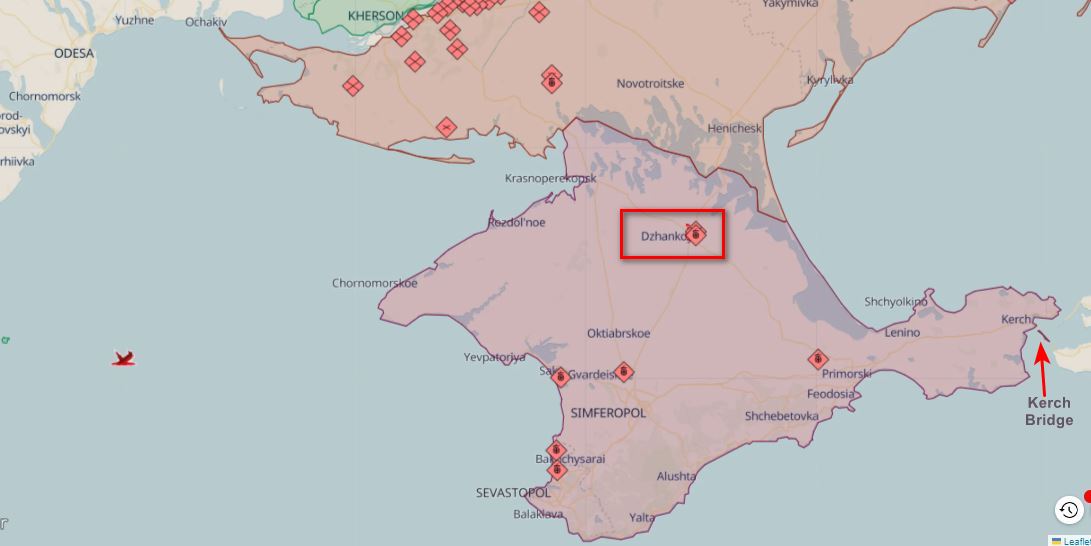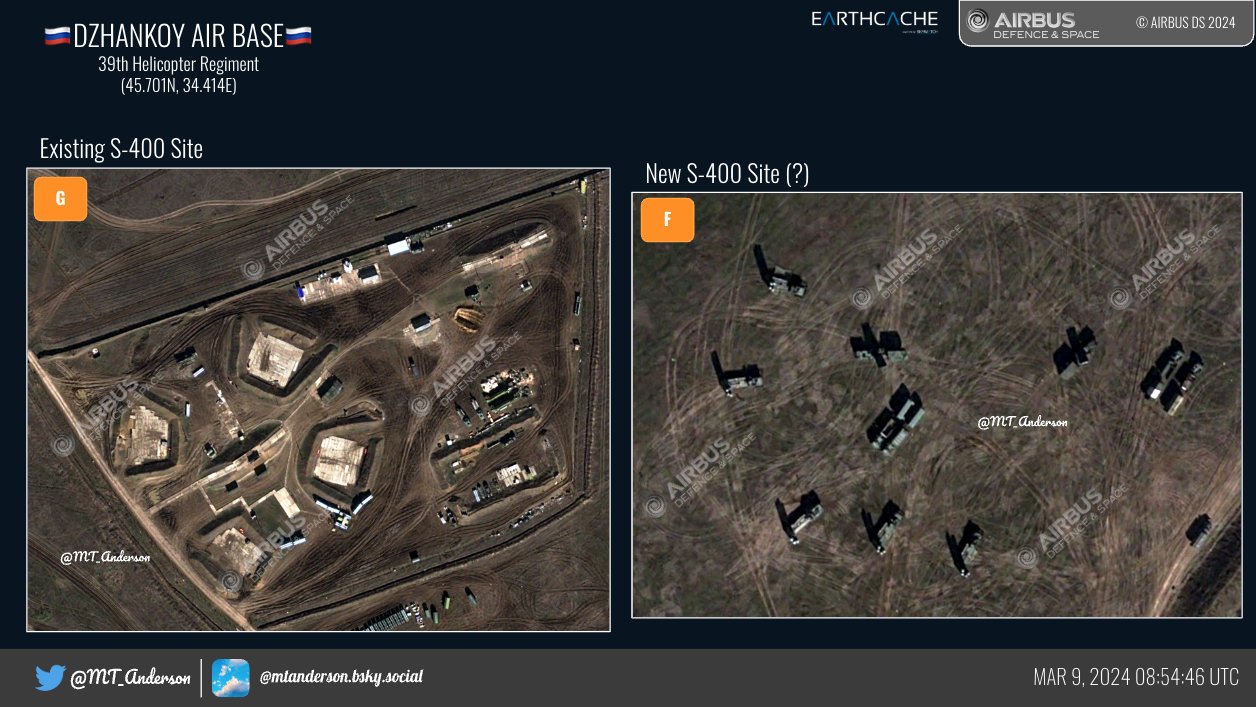Early on 17 March, the Ukrainian armed forces have carried out a successful strike on a Russian helicopter base in Dzhankoi, occupied Crimea, reportedly destroying multiple air defense systems, including four launchers of the long-range S-400 "Triumf" surface-to-air missile system, three radar stations, an air defense control center, and a airspace surveillance system.
The attack is believed to have significantly decreased the Russian combat potential in the area and could pave the way for further Ukrainian operations in Crimea.

Here is what we know about the April 17 Dzhankoi airfield strike.
Initial reports on the Dzhankoi attack
Overnight on 17 April, explosions were heard in the temporarily occupied Crimea. Russian sources reported explosions and air defense activity, followed by a fire in the city of Dzhankoi near the military airfield, hosting Russia's 39th Helicopter Regiment, which operates military helicopters including the Mi-8, Mi-35M, Mi-28, and Ka-52, and may also accommodate the helicopters of Russia's FSB Border Service.
Multiple videos of the fires in the area of the helicopter base started circulating on social media. The first video in our tweet clearly shows secondary detonations within the blaze, suggesting the presence of explosive materials within the intense conflagration zone
https://twitter.com/EuromaidanPress/status/1780478799945277452
"We could hear it very well in Azovske (a town 20 km southeast of Dzhankoi, - Ed.). The airfield is also located to the south of Dzhankoi. The explosions started around 3:30 a.m. I heard probably more than ten explosions of different strengths. Some were very powerful, the windows in the house were shaking," a local resident told Suspilne.
The Russian occupation administration's Minister of Transport of Crimea Nikolai Lukashenka said that the section of the road from Dzhankoi to Pobedne village was temporarily blocked.
Details of the Ukrainian attack as per unofficial sources
Citing its unnamed sources, the Russian Telegram channel Astra said that the military airfield in Dzhankoi was attacked using ballistic missiles. This suggests that of the ballistic missiles Ukraine possesses, only the US-supplied ATACMS could have been used in the attack.
A month ago, on 9 March, there were 16 Russian helicopters at the Dzhankoi base, according to satellite imagery data:
https://twitter.com/MT_Anderson/status/1768029602570494257
The Russian military blogger Colonel Cassad claimed
that the Ukrainian attack "hit an ammunition depot and damaged air defense positions."
The March 9 satellite imagery of the Dzhankoi air base showed that the Russian S-400 SAM battery seemingly moved to a new location in a nearby field as of that date:

Infographic by Twitter/MT Anderson based on images courtesy of Airbus DS.
Ukrainian Telegram channel Krymskyi Veter noticed that the new location of the Russian S-400 battery spotted by MT Anderson earlier was marked as a fire on the NASA FIRMS map on the day of the attack. In total, the NASA FIRMS map showed six thermal anomalies in the area of the Dzhankoi airfield:
Ukrainian Telegram channel earlier spotted a Russian S-400 air defense system at one of the spots now marked as fires at NASA FIRMS. https://t.co/em6dpD1A7J pic.twitter.com/KBbBDh2OMs
— Euromaidan Press (@EuromaidanPress) April 17, 2024
On the afternoon of 17 April, the Russian Telegram channel Dosye Shpiona shared the photo of the destroyed S-400 Triumf SAM complex and claimed the following:
- Ukraine hit the base with two MGM-140 ATACMS missiles.
- The first strike hit the S-400 system, destroying three launchers and "RLS," meaning a radar or radars.
- The second strike struck a reception and repair facility for military equipment of the 77th Anti-Aircraft Missile Brigade. "At the time of the strike, two S-300 launchers (of unspecified modification) were being serviced at the point. Also, as a result of the strike, there was a secondary detonation of ammunition at the station. It is not known what exactly exploded," the channel stated.
- "There is no information about damaged helicopters yet."
- As of 6 a.m. on 17 April, there were 15 injured and 22 missing.
Ukrainian official confirmation of the Crimea attack
In his evening address to the nation on 17 April, Ukraine's President Zelenskyy confirmed the Ukrainian strike on the airfield near Dzhankoi.
"Today, the Armed Forces of Ukraine executed a proper strike on the occupier at the Dzhankoi airfield. Thank you, warriors, for your accuracy, and thank you to the Commander-in-Chief, [Oleksandr] Syrskyi, for organizing the operation," he said.
The next morning, Andrii Yusov, a representative of the Main Directorate of Intelligence (HUR) of the Ministry of Defense of Ukraine, told Radio Svoboda
:
"There are launchers of anti-missile and anti-air defense systems, destroyed radar systems, and information about the affected aircraft. All the information will be made public later today. This is a serious harvest and a successful operation of the Armed Forces of Ukraine," he noted.
Around noon on 18 April, the HUR published a short report, claiming that the "successful operation" of the Armed Forces of Ukraine that targeted the Russian military airfield at Dzhankoi on 17 April resulted in the destruction or critical damage to eight units of the Russian air defense equipment and a control center.
The HUR mentioned the following Russian losses:
- 4 launchers of the S-400 surface-to-air missile system;
- 3 radar stations;
- an air defense control center;
- Fundament-M airspace surveillance equipment.
According to HUR, "the number of the enemy's destroyed or damaged aviation objects (i.e. air assets, - Ed.) and the number of casualties among the personnel of the Russian occupation army is being clarified."
Later on 14 April, the General Staff of the Armed Forces of Ukraine put out its version of the report about the Dzhankoi attack.
"Overnight on 16-17 April, the Ukrainian Defense Forces launched a missile strike and hit designated Russian military targets on the territory of the temporarily occupied Autonomous Republic of Crimea," the General Staff said, further listing the Russian assets mentioned earlier by the HUR as "minus'ed," i.e., destroyed.
The clip featured in the General Staff's report showed the launch of six missiles:
https://twitter.com/EuromaidanPress/status/1780963594106249414
"The enemy is carefully concealing the number of affected aircraft and personnel," the General Staff noticed, adding that the attack has "significantly decreased" the Russian combat potential.
A Ukrainian Telegram channel shared first-person-view on two missile launches filmed by a Ukrainian operator of the M270 MLRS system:
"Footage of yesterday's 'fat' missile launches at Crimea from the GoPro camera of M270 MLRS operator." (https://t.co/bY1JhtbXBN) pic.twitter.com/ZzCcjv6Dhm
— English Luhansk (@loogunda) April 18, 2024
Implications: what's next?
It is worth noting that in a similar fashion, the Ukrainian strike on Russia's Black Sea Fleet HQ in Sevastopol in September 2023 was preceded by the destruction of another Russian S-400 SAM system in Evpatoria. This initial attack weakened the air defenses on Crimea's western coast, enabling subsequent missile strikes to reach their targets. Combined with naval drone assaults, this later forced the Russians to relocate most of their remaining Black Sea Fleet warships from Sevastopol to Russia's Novorossiysk on the Black Sea's eastern coast, which is out of range of Ukrainian missiles.
Thus, targeting Russian long-range air-defense assets in Dzhankoi suggests that the attack might have enabled Ukraine to launch more missiles from the north across Crimea's isthmus, connecting the peninsula to mainland Ukraine, rather than from the northwest across the sea, where they are more vulnerable over the sea surface.
The Russian military blogger Colonel Cassad sees more severe implications and speculates that in this way, the Ukrainian forces "are conducting targeted preparations for more intensive attacks on the peninsula," also citing some failed attack on a Russian command point in occupied Berdiansk on the Azov coast shortly before the Dzhankoi airfield strike. He further speculates that the objective of such Ukrainian attacks is to deprive Russian units of coordination by destroying command centers and to inflict maximum damage on air defense forces.
"It is the fulfillment of these two goals, taking into account the already weakened [Russia's Black Sea] Fleet, that the [Ukrainian Armed Forces] need before attacking the Crimean bridge," he believes.
The Kerch bridge that Russia calls the Crimean bridge connects the occupied Crimea to Russia. Out of the range of most Ukrainian weapons, this is the main safe route for Russian military logistics sustaining the Russian forces in Crimea and in other Russian-occupied areas north of Crimea.
Earlier, HUR chief Kyrylo Budanov told The Guardian that Ukraine plans to destroy the bridge in the first half of 2024.
Read also:
- Dzhankoi airfield in occupied Crimea targeted in strikes
- The Guardian: Ukraine plans to destroy Kerch bridge by June
- Sources say high-ranking Russian officers hit by strike in occupied Crimea
- Ukrainian missile attack sparks fire at warehouse in occupied Crimea
- Blasts heard in Dzhankoi, occupied Crimea, in alleged Ukrainian drone attack on railway hub (updated)

